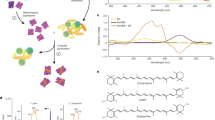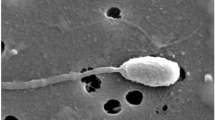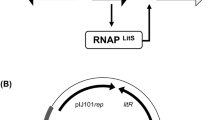Abstract
Bacteria that inhabit glaciers usually produce carotenoids. Here, we report that a group of zeaxanthin-producing glacial Flavobacterium exhibited light-promoted growth. Of the tested 47 strains, 45 showed increased growths but two died under illumination at 50 μmol photon m−2 s−1. Light stimulation occurred mainly in either anoxic or nutrient-poor cultures, while the same levels of light promotion were found for that grown at 14 and 7 °C. Pigment assays identified overrepresentative zeaxanthin but trace retinal in the light promoted 45 strains, while flexirubin was exclusively in the light-lethal two. Genomic analysis revealed the gene cluster for zeaxanthin synthesis in the 45 strains, in which 37 strains also harbored the proteorhodopsin gene prd. Transcriptomic analysis found that light-induced expressions of both the zeaxanthin synthesis and proteorhodopsin genes. Whereas, deletion of the prd gene in one strain did not diminish light promotion, inhibition of zeaxanthin synthesis did. In comparison, no light promotion was determined in a glacier Cryobacterium luteum that produced a non-zeaxanthin-type carotenoid. Therefore, light stimulation on the glacial Flavobacterium is mostly likely related to zeaxanthin, which could provide better photoprotection and sustain membrane integrity for the organisms living in cold environments.
Similar content being viewed by others
Log in or create a free account to read this content
Gain free access to this article, as well as selected content from this journal and more on nature.com
or
Data availability
All the genomic and RNA-seq data have been deposited under the NCBI BioProject accession number PRJNA382862, in which the complete genomic data of strains XB07 and XB36 are under the accession numbers of CP049329 and CP062159, respectively.
References
Amato P, Hennebelle R, Magand O, Sancelme M, Delort AM, Barbante C, et al. Bacterial characterization of the snow cover at Spitzberg, Svalbard. FEMS Microbiol Ecol. 2007;59:255–64.
Liu Y, Yao T, Jiao N, Kang S, Xu B, Zeng Y, et al. Bacterial diversity in the snow over Tibetan Plateau Glaciers. Extremophiles. 2009;13:411–23.
Simon C, Wiezer A, Strittmatter AW, Daniel R. Phylogenetic diversity and metabolic potential revealed in a glacier ice metagenome. Appl Environ Microbiol. 2009;75:7519–26.
Peeters K, Ertz D, Willems A. Culturable bacterial diversity at the Princess Elisabeth Station (Utsteinen, Sor Rondane Mountains, East Antarctica) harbours many new taxa. Syst Appl Microbiol. 2011;34:360–7.
Philippot L, Tscherko D, Bru D, Kandeler E. Distribution of high bacterial taxa across the chronosequence of two alpine glacier forelands. Micro Ecol. 2011;61:303–12.
Wilhelm L, Singer GA, Fasching C, Battin TJ, Besemer K. Microbial biodiversity in glacier-fed streams. ISME J. 2013;7:1651–60.
Liu Q, Zhou YG, Xin YH. High diversity and distinctive community structure of bacteria on glaciers in China revealed by 454 pyrosequencing. Syst Appl Microbiol 2015;38:578–85.
Liu Q, Xin YH, Zhou YG, Chen WX. Multilocus sequence analysis of homologous recombination and diversity in Arthrobacter sensu lato named species and glacier-inhabiting strains. Syst Appl Microbiol. 2018;41:23–9.
Liu Q, Song WZ, Zhou YG, Dong XZ, Xin YH. Phenotypic divergence of thermotolerance: Molecular basis and cold adaptive evolution related to intrinsic DNA flexibility of glacier-inhabiting Cryobacterium strains. Environ Microbiol. 2020;22:1409–20.
Liu Q, Liu HC, Zhou YG, Xin YH. Microevolution and adaptive strategy of psychrophilic species Flavobacterium bomense sp. nov. isolated from glaciers. Front Microbiol. 2019;10:1069.
Zhang S, Yang G, Wang Y, Hou S. Abundance and community of snow bacteria from three glaciers in the Tibetan Plateau. J Environ Sci. 2010;22:1418–24.
Schutte UM, Abdo Z, Foster J, Ravel J, Bunge J, Solheim B, et al. Bacterial diversity in a glacier foreland of the high Arctic. Mol Ecol. 2010;19:54–66.
Dieser M, Greenwood M, Foreman CM. Carotenoid pigmentation in Antarctic heterotrophic bacteria as a strategy to withstand environmental stresses. Arct Antarct Alp Res. 2010;42:396–405.
Pandey N, Jain R, Pandey A, Tamta S. Optimisation and characterization of the orange pigment produced by a cold adapted strain of Penicillium sp. (GBPI_P155) isolated from mountain ecosystem. Mycology. 2018;9:81–92.
Vila E, Hornero-Méndez D, Azziz G, Lareo C, Saravia V. Carotenoids from heterotrophic bacteria isolated from Fildes Peninsula, King George Island, Antarctica. Biotechnol Rep. 2019;21:e00306.
Shen L, Liu Y, Wang N, Jiao N, Xu B, Liu X. Variation with depth of the abundance, diversity and pigmentation of culturable bacteria in a deep ice core from the Yuzhufeng Glacier, Tibetan Plateau. Extremophiles. 2018;22:29–38.
Klassen JL, Foght JM. Differences in carotenoid composition among hymenobacter and related strains support a tree-like model of carotenoid evolution. Appl Environ Microbiol. 2008;74:2016–22.
Collins T, Margesin R. Psychrophilic lifestyles: mechanisms of adaptation and biotechnological tools. Appl Microbiol Biotechnol. 2019;103:2857–71.
Tracewell CA, Vrettos JS, Bautista JA, Frank HA, Brudvig GW. Carotenoid photooxidation in photosystem II. Arch Biochem Biophys. 2001;385:61–9.
Sandmann G. Bleaching Herbicides: action mechanism in carotenoid biosynthesis, structural requirements and engineering of resistance. In: (Böger KW, Hirai K, editors. Herbicide classes in development. Springer Verlag; 2002.
Palozza P, Krinsky NI. Antioxidant effects of carotenoids in vivo and in vitro: an overview. Methods Enzymol. 1992;213:403–20.
Bowman JP, McCammon SA, Brown MV, Nichols DS, McMeekin TA. Diversity and association of psychrophilic bacteria in Antarctic sea ice. Appl Environ Microbiol. 1997;63:3068–78.
Chattopadhyay MK, Jagannadham MV, Vairamani M, Shivaji S. Carotenoid pigments of an Antarctic psychrotrophic bacterium Micrococcus roseus: temperature dependent biosynthesis, structure, and interaction with synthetic membranes. Biochem Biophys Res Commun. 1997;239:85–90.
Jagannadham MV, Chattopadhyay MK, Subbalakshmi C, Vairamani M, Narayanan K, Rao CM, et al. Carotenoids of an Antarctic psychrotolerant bacterium, Sphingobacterium antarcticus, and a mesophilic bacterium, Sphingobacterium multivorum. Arch Microbiol. 2000;173:418–24.
Zhu F, Wang S, Zhou P. Flavobacterium xinjiangense sp. nov. and Flavobacterium omnivorum sp. nov., novel psychrophiles from the China No. 1 glacier. Int J Syst Evol Microbiol. 2003;53:853–7.
Zhu L, Liu Q, Liu H, Zhang J, Dong X, Zhou Y, Xin Y. Flavobacterium noncentrifugens sp. nov., a psychrotolerant bacterium isolated from glacier meltwater. Int J Syst Evol Microbiol. 2013;63:2032–7.
Béjà O, Aravind L, Koonin EV, Suzuki MT, Hadd A, Nguyen LP, et al. Bacterial rhodopsin: evidence for a new type of phototrophy in the sea. Science. 2000;289:1902–6.
Fuhrman JA, Schwalbach MS, Stingl U. Proteorhodopsins: an array of physiological roles? Nat Rev Microbiol. 2008;6:488–94.
Gómez-Consarnau L, González JM, Coll-Lladó M, Gourdon P, Pascher T, Neutze R, et al. Light stimulates growth of proteorhodopsin-containing marine Flavobacteria. Nature. 2007;445:210–13.
Yoshizawa S, Kumagai Y, Kim H, Ogura Y, Hayashi T, Hayashi T, et al. Functional characterization of flavobacteria rhodopsins reveals a unique class of light-driven chloride pump in bacteria. Proc Natl Acad Sci USA. 2014;111:6732–7.
Kim OS, Cho YJ, Lee K, Yoon SH, Kim M, Na H, et al. Introducing EzTaxon-e: a prokaryotic 16S rRNA gene sequence database with phylotypes that represent uncultured species. Int J Syst Evol Microbiol. 2012;62:716–21.
Cunningham FX Jr, Sun Z, Chamovitz D, Hirschberg J, Gantt E. Molecular structure and enzymatic function of lycopene cyclase from the cyanobacterium Synechococcus sp. strain PCC7942. Plant Cell. 1994;6:1107–21.
Armstrong G. Carotenoid genetics and biochemistry. In: Cane DE, editor. Isoprenoids including carotenoids and steroids. Vol. 2. Amsterdam, The Netherlands: Elsevier; 1999. p. 321–52.
Reichenbach H. Order Cytophagales Leadbetter 1974. In: Staley JT, Bryant MP, Pfennig N, and Holt JG, editors. Bergey’s manual of systematic bacteriology. MD: Williams and Wilkins Baltimore; 1989. p. 2011–82.
Rodriguez-Amaya DB, Kimura M. Harvest plus handbook for carotenoid analysis. Washington: International Food Policy Research Institute and International Center for Tropical Agriculture (CIAT); 2004. p. 58
Sabehi G, Loy A, Jung KH, Partha R, Spudich JL, Spudich JL, et al. New insights into metabolic properties of marine bacteria encoding proteorhodopsins. PLoS Biol. 2005;3:e273.
Bankevich A, Nurk S, Antipov D, Gurevich AA, Dvorkin M, Kulikov A, et al. SPAdes: a new genome assembly algorithm and its applications to single-cell sequencing. J Comput Biol. 2012;19:455–77.
Langmead B, Salzberg SL. Fast gapped-read alignment with Bowtie 2. Nat Methods. 2012;9:357–9.
Trapnell C, Roberts A, Goff L, Pertea G, Kim D, Kelley DR, et al. Differential gene and transcript expression analysis of RNA-seq experiments with TopHat and Cufflinks. Nat Protoc. 2012;7:562–78.
Li N, Qin T, Zhang XL, Huang B, Liu ZX, Xie HX, et al. Gene deletion strategy to examine the involvement of the two chondroitin lyases in Flavobacterium columnare virulence. Appl Environ Microbiol. 2015;81:7394–402.
Morita RY. Psychrophilic bacteria. Bacteriol Rev. 1975;39:144–67.
Miller GL. Use of dinitrosalicylic acid reagent for determination of reducing sugar. Anal Chem. 1959;31:426–8.
Feng S, Powell SM, Wilson R, Bowman JP. Light-stimulated growth of proteorhodopsin-bearing sea-ice psychrophile Psychroflexus torquis is salinity dependent. ISME J. 2013;7:2206–13.
Giovannoni SJ, Bibbs L, Cho JC, Stapels MD, Desiderio R, Vergin KL, et al. Proteorhodopsin in the ubiquitous marine bacterium SAR11. Nature. 2005;438:82–5.
Walter JM, Greenfield D, Bustamante C, Liphardt J. Light-powering Escherichia coli with proteorhodopsin. Proc Natl Acad Sci USA. 2007;104:2408–12.
Shivaji S, Prakash JS. How do bacteria sense and respond to low temperature? Arch Microbiol. 2010;192:85–95.
Bernardet JF, Bowman JP. Genus Flavobacterium. In: Krieg NR, Staley JT, Brown DR, Hedlund BP, Paster BJ, editors. Bergey’s manual of systematic bacteriology. Vol 4. 2nd ed. New York: Springer; 2010. p. 112–54.
Ballottari M, Alcocer MJ, D’Andrea C, Viola D, Ahn TK, Petrozza A, et al. Regulation of photosystem I light harvesting by zeaxanthin. Proc Natl Acad Sci USA. 2014;111:E2431–8.
Kupisz K, Sujak A, Patyra M, Trebacz K, Gruszecki WI. Can membrane-bound carotenoid pigment zeaxanthin carry out a transmembrane proton transfer? Biochim Biophys Acta. 2008;1778:2334–40.
Noinaj N, Guillier M, Barnard TJ, Buchanan SK. TonB-dependent transporters: regulation, structure, and function. Annu Rev Microbiol. 2010;64:43–60.
Sowmya R, Sachindra NM. Biochemical and molecular characterization of carotenogenic Flavobacterial isolates from marine waters. Pol J Microbiol. 2016;65:77–88.
Asker D, Beppu T, Ueda K. Mesoflavibacter zeaxanthinifaciens gen. nov., sp. nov., a novel zeaxanthin-producing marine bacterium of the family Flavobacteriaceae. Syst Appl Microbiol. 2007;30:291–6.
Acknowledgements
The authors sincerely thank Prof. Pin Nie at the Institute of Hydrobiology at the Chinese Academy of Sciences for kindly providing E. coli strain S17-1 λpir and plasmid pMS75. The research was supported by the National Natural Science Foundation of China under grants 91751203 and 31670003.
Author information
Authors and Affiliations
Corresponding authors
Ethics declarations
Conflict of interest
The authors declare that they have no conflict of interest.
Additional information
Publisher’s note Springer Nature remains neutral with regard to jurisdictional claims in published maps and institutional affiliations.
Supplementary information
Rights and permissions
About this article
Cite this article
Liu, Q., Li, W., Liu, D. et al. Light stimulates anoxic and oligotrophic growth of glacial Flavobacterium strains that produce zeaxanthin. ISME J 15, 1844–1857 (2021). https://doi.org/10.1038/s41396-020-00891-w
Received:
Revised:
Accepted:
Published:
Issue date:
DOI: https://doi.org/10.1038/s41396-020-00891-w
This article is cited by
-
Flavobacterium algoriphilum sp. nov., Flavobacterium arabinosi sp. nov., Flavobacterium cryoconiti sp. nov., Flavobacterium galactosi sp. nov., Flavobacterium melibiosi sp. nov., and Flavobacterium algoris sp. nov., six novel cold-adapted bacteria isolated from glaciers
BMC Microbiology (2025)
-
Exploration on cold adaptation of Antarctic lichen via detection of positive selection genes
IMA Fungus (2024)
-
Alpine and subalpine plant microbiome mediated plants adapt to the cold environment: A systematic review
Environmental Microbiome (2024)
-
Microbial chassis as the platform for production of dihydroxy xanthophyll-based carotenoids: an overview of recent advances in biomanufacturing
World Journal of Microbiology and Biotechnology (2024)
-
Globally distributed Myxococcota with photosynthesis gene clusters illuminate the origin and evolution of a potentially chimeric lifestyle
Nature Communications (2023)



